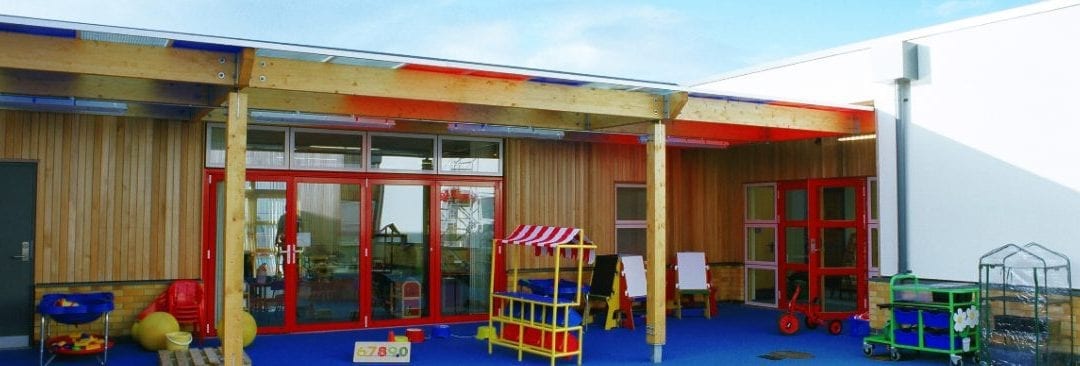Outdoor classrooms are flexible wonder buildings that enhance your school in more ways than one.
Have you ever wondered what exactly an outdoor classroom is? Or do you consider an outdoor classroom to be specifically for nature studies only? If you answered yes to any of these questions, you’re not alone. Most schools who install a school canopy don’t, at first, realise the potential that outdoor learning canopies can bring to their students, their staff, or their school.
Keep on reading to learn why we consider outdoor classrooms to have a positive impact on any school that installs one.
What Is An Outdoor Classroom?
Outdoor classrooms are spaces that allow teachers to hold lessons outdoors. Most people think of an outdoor classroom as an area within your school grounds which is set up so children can study nature and the outdoors. It’s very common for pre-school and infant school children to be the primary beneficiaries of an outdoor ‘nature’ classroom.
And while such a classroom is a fantastic idea, the idea of using an outdoor classroom for this purpose and age group alone is limiting. It doesn’t matter what subject you’re teaching or how old your students are. Though there will be some limitations, as having a cooking or technical class outdoors might be difficult. But classes like Maths, English, Art, Music, Science and Drama can easily adapt to an outdoor class setting.
The best and most effective outdoor classrooms occur under some kind of shelter, like the outdoor classroom canopies we discuss further on in this article.
Why Choose An Outdoor Classroom?
There are many reasons why choosing an outdoor classroom for your school is advantageous. Some of the most popular reasons are the increases in health and academic performance:
Increased Academic Performance
The list of ways academic performance increases from spending time outdoors is long. There are so many advantages that we couldn’t list them all here. A study by the National Wildlife Federation demonstrates how grades increase significantly just by encouraging children to spend less time on games and other media. Having an outdoor classroom can help children to build a relationship with the outdoors, improve their grades and learn how to enjoy life without relying on media for fun.
And the same study shows how 75% of students who spend regular time outdoors tend to be more creative and better able to problem solve in the classroom.
Improved Mental, Emotional, Social and Physical Health
Outdoor learning also encourages activities which improve the student’s physical, emotional and social health. A study from the Open University shows that time outdoors improves wellbeing, reduces mental health problems, and increases life expectancy. Spending time outdoors improves even helps to strengthen our immune systems because we are exposed to a natural source of Vitamin D.
What Should Be In An Outdoor Classroom?
There’s no hard and fast rule about what you should include in an outdoor classroom. Some of the best outdoor classroom ideas we’ve found demonstrate that deciding what should be in an outdoor classroom depends on what activities you’re going to use that classroom for.
For very basic outdoor classroom ideas you’ll need:
- Shelter from the elements, like an outdoor classroom canopy
- A seating area, like tree stumps, logs, foldable chairs, picnic benches
To take it to the next level you might consider including the following into your outdoor classroom:
- Tables: foldable tables, picnic tables, or outdoor desks
- A chalkboard/portable whiteboard
For a nature classroom
- Reading nooks
- Nature/gardening stations
- Blankets
- Exercise equipment
There’s plenty of inspiration on this helpful article for how to create a nature classroom. You can even find outdoor science benches for younger children.
For permanent, ‘all-weather’ outdoor classrooms you will need the same furniture you use in your usual classrooms, outdoor classroom furniture or foldable classroom furniture if you plan to use your all-weather outdoor learning canopy for other purposes.
How Do You Build An Outdoor Classroom Canopy?
You can create an outdoor classroom by building nooks and shelters from wood, blankets and tents which are adequate for creating a nature classroom, or for taking the class outside now and again. But they’ll need a lot of maintenance and effort to store and rebuild every time you want to go out – especially in British weather!
The best way to build an outdoor learning canopy is to bring in the professionals. Some businesses specialise in building outdoor learning canopies for schools.
While building an outdoor classroom canopy is much easier than building an extension to your school. It still requires careful planning, preparation and installation. So if you’re thinking about building an outdoor classroom canopy, your first stop should be to seek out professional advice from a canopy company.
What Types Of Outdoor Classroom Canopies Can I Build?
There are three main types of classroom canopies that professionals can install to your school premises:
1. School Canopies
Don’t let the name of these canopies deceive you. A classroom canopy can range in shelter from a simple roof cover to a fully-fledged, enclosed classroom that you can open up to the elements in the summer and keep warm, lit and cosy in the winter.
Canopies often have a steel or aluminium frame with either a polycarbonate roof or a fabric tepee style roof. The side infills are optional and usually come with a variety of choices like; doors, windows or shutters. With a school learning canopy, you can permanently create an ‘all seasons’ outdoor canopy that can open up to the elements any time you desire.
2. Timber Framed Forest School Shelters
Timber framed forest school shelters are school learning canopies that often incorporate climbing frames, play areas, lookouts and enclosed areas for full shelter from the elements. They look fantastic and inspire a lot of creativity because they encourage a deep connection to nature.
From a practical perspective, you can install timber-framed classroom canopies that are fully enclosed and suitable for all-weather use, and they don’t need to be a ‘forest school’. You can install a timber-framed school learning canopy that looks like a wooden lodge.
3. Shade Sails and Parasols
Shade sails and parasols range in the amount of shelter they give from the elements. Shade sails are more extensive, while parasols usually sit over one or a few picnic tables providing shade.
These canopy types are more suitable for warmer weather since you can’t fill in the sides or add heaters. But they are very flexible and can support outdoor learning and outdoor dining while providing ample shelter from the sun during break times for when the weather is hot. They’re very versatile and a great companion to a fully enclosed school shelter.
An outdoor classroom doesn’t have to be reserved solely for nature classes. You can take all other types of classes outdoors. But you should provide enough protection from the elements to protect your children during class and to keep them safe and focused on the lessons.
Outdoor classroom canopies are the best way to protect and contain your classes when they’re outdoors. Primarily because you can design them so that they are enclosed, heated classrooms for the wintertime. But in the summer, you can roll up the shutters and allow your students to study outdoors.
The only downside we can see is that once you get one, you will have wished you had done it years ago!

